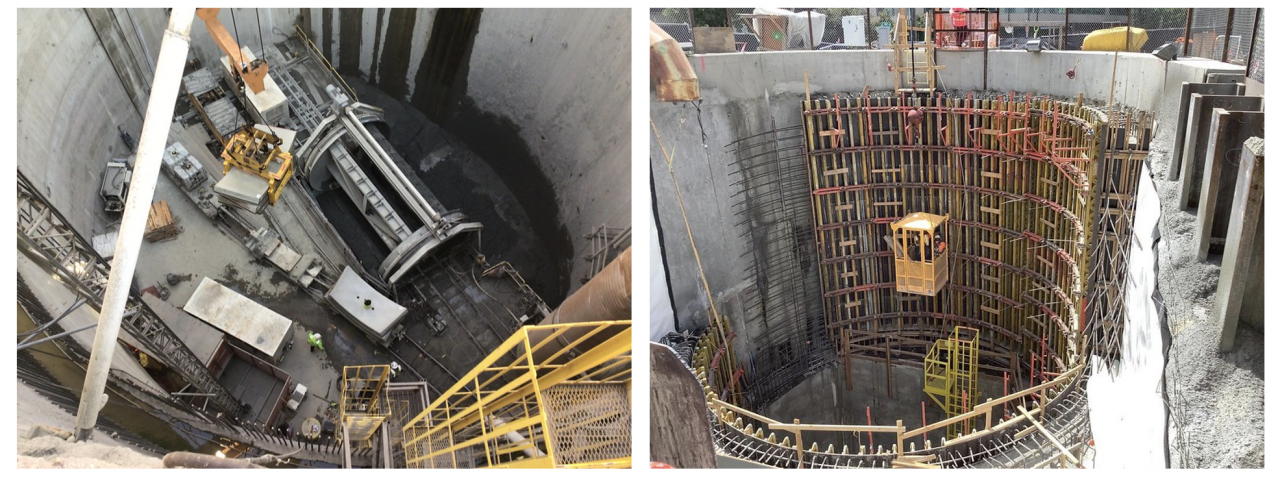
The Ship Canal Water Quality Project includes a 2.7-mile, 18’10”-diameter tunnel that will extend from Ballard to Wallingford. Left: Ballard Tunnel Segment. Right: Wallingford Shaft Site. Photos supplied in December 2022 courtesy Seattle Public Utilities.
Seattle Public Utilities and King County’s Wastewater Treatment Division are completing an underground storage tunnel to reduce the amount of polluted stormwater runoff and sewage that flows in the Lake Washington Ship Canal, Salmon Bay, and Lake Union from the sewer system.
In some parts of Seattle (as with many other places), stormwater and sewage share a set of pipes — a combined sewer system which, during heavy storm/rain events, overflows when pipe capacity is exceeded. Untreated sewage and stormwater then flow directly into the Ship Canal, posing public health concerns and harming fish, wildlife, and the environment. The Ship Canal Water Quality Project is crucial for keeping the waterways clean and protecting human health and the environment over the long term.
This project is funded in part by the Washington State Department of Ecology and the Environmental Protection Agency through the State Revolving Fund and Water Infrastructure Finance and Innovation Act loans. The project includes a 2.7-mile, 18-ft and 10-in internal diameter tunnel, which can capture and temporarily hold more than 29 million gallons of stormwater and sewage during heavy rains. As the heavy rains subside, flows will be sent to King County’s West Point Wastewater Treatment Plant in Magnolia for treatment. An above-grade facility known as the Tunnel Effluent Pump Station (TEPS) and surrounding site development are crucial components of this project, along with two portals (West Portal and East Portal, or Ballard Site and Wallingford Site, respectively) that serve as access and egress for the tunnel boring machine that is needed to construct the tunnel. In addition, this project involves the reconstruction of the 24th Avenue NW pier, the implementation of odor-control facilities, and the construction of a drop structure and conveyance facilities, which are needed to convey influent combined sewer overflow (CSO) into the storage tunnel and to drain flows from the tunnel.
The Envision® sustainable infrastructure framework and rating system was deemed the best fit for this project due to its comprehensive nature and its applicability to the entire infrastructure system and the site development included in this project. The Ship Canal Water Quality Project scored exceptionally well across all five Envision credit categories: Quality of Life, Leadership, Resource Allocation, Natural World, and Climate and Resilience, earning this project an Envision Platinum rating from the Institute for Sustainable Infrastructure.
KEY SUSTAINABILITY ACHIEVEMENTS
— Significant water quality improvements to prevent 75 million gallons of polluted stormwater and sewage from entering the waterways on average each year.
— Expansion of public space and amenities through the reconstruction of the 24th Avenue NW Pier, street improvements leading up to the pier, and the installation of public art. The Pieris used by pedestrians and recreationalists for water access, shoreline viewing, and mooring small vessels. Therefore, replacing and improving the Pier to enable this continued use and access is an essential part of the project, as is improving the street conditions leading up to the pier. In addition, Seattle Public Utilities, in partnership with the Office of Arts & Culture, has commissioned a suite of artworks that will “make the invisible visible” by drawing attention to the vital role this project plays in keeping the waterways safe and clean; and create meaningful, thoughtful, and inspiring art experiences in the public realm. For example, at the east shaft (Wallingford) site, the artwork will illustrate water usage connections, city planning, hardscapes, waterways, and underground systems. At the Fremont/Queen Ann locations, the artwork will convey traditional native stories by featuring two large-scale canoe-paddle sculptures constructed of glass and steel that will flank each side of the Ship Canal waterway.
— Use of phytoremediation, a land-use control to remediate and limit future contamination, was used as part of the green stormwater infrastructure at the Ballard Site. Phytoremediation involves the use of plants to remediate sites. Plants can degrade organic pollutants and can contain and stabilize metal contaminants by acting as filters or traps.
— Preservation of critical cultural resources through the implementation of a memorandum of understanding with Muckleshoot Indian Tribe that outlines barging protocols and mitigation measures to address impacts to fishing activities and access.
— Innovative implementation of a curved conveyance pipeline crossing the Lake Washington Ship Canal to connect the new diversion to the Fremont Shaft. The original plan was to implement a deep and straight pipeline connecting the 3rd Avenue conveyance to the storage tunnel, but the idea of an innovative curved micro-tunnel was raised to reduce costs and materials and reduce impacts to the Fremont site and environmentally sensitive shoreline. The implementation of this curved conveyance pipeline is one of the first such applications in North America.
— Leadership in preparing for climate change impacts. The project team conducted a thorough analysis of potential impacts to Seattle’s water supply, drainage, wastewater systems, and tidally-influenced infrastructure. They integrated this information and analysis into project decision-making. The team collaborated with the scientific community as well as local, national, and international water utilities to share findings, enhance their knowledge of potential climate-change impacts, and improve their capacity to prepare for impacts related to sea-level rise, changes in water availability, changes in winter and summer precipitation levels, increased forest fires, and changes in the timing of stream flows which could affect the functioning of the project.
— Job creation and skills development through crafting of strong community workforce agreements that support training and utilization of local craft workers; through means of promoting and ensuring women and people of color are able to access meaningful work on the project; by supporting contractor efforts and obligations to utilize women-owned and minority-owned firms; and by supporting veteran workers and investing in apprenticeships.
PROJECT DETAILS AT-A-GLANCE
Envision-verified project: Ship Canal Water Quality Project
Location: Seattle, Washington
Lead Envision Firm: HDR
Envision Rating: Platinum
Award Date: TBD
Project Owner(s): Seattle Public Utilities and King County Wastewater Treatment Division
Project Phase: Under construction
Project Delivery Method: Design-Bid-Build
For More Information: Visit the project website.
Download the Project Profile & Award Announcement.



